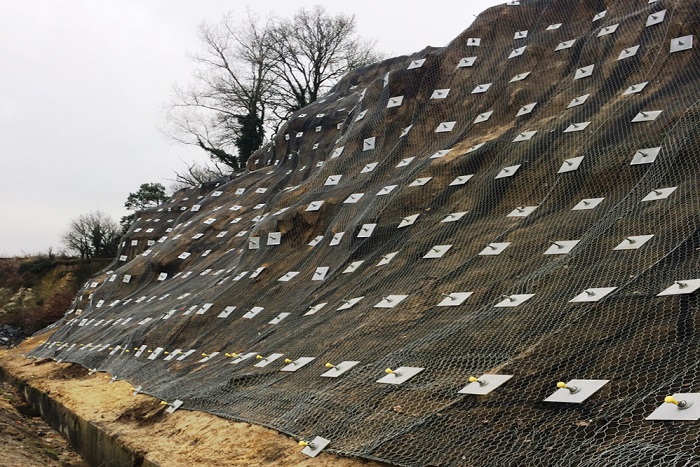Soil nailing
Soil nailing is a ground stabilisation technique that can be used on either natural or excavated slopes. It involves drilling holes for steel bars to be inserted into a slope face which are then grouted in place. Mesh is attached to the bar ends to hold the slope face in position.
They are commonly used as a remedial measure to stabilise embankments, levees, and so on. Other applications for soil nailing include:
- Temporary excavation shoring.
- Tunnel portals.
- Roadway cuts.
- Under bridge abutments.
- Repair and reconstruction of existing retaining structures.
The main considerations for deciding whether soil nailing will be appropriate include; the ground conditions, the suitability of other systems, such as ground anchors, geosynthetic materials, and so on and cost.
Although soil nails are versatile and can be used for a variety of soil types and conditions, it is preferable that the soil should be capable of standing – without supports – to a height of 1-2 m for no less than 2 days when cut vertical or near-vertical.
Soils which are particularly suited to soil nailing include clays, clayey silts, silty clays, sandy clays, glacial soils, sandy silts, sand, gravels. Soil nailing can be used on weathered rock as long as the weathering is even (i.e. without any weakness planes) throughout the rock.
Soils which are not well-suited to soil nailing include those with a high groundwater table, cohesion-less soils, soft fine-grained soils, highly-corrosive soils, loess, loose granular soils, and ground exposed to repeated freeze-thaw action.
Design considerations that will inform the design include:
- Strength limit: The limit state at which potential failure or collapse occurs.
- Service limit: The limit state at which loss of service function occurs resulting from excessive wall deformation.
- Height and length.
- Vertical and horizontal spacing of the soil nails.
- Inclination of the soil nails.
- Ground properties.
- Nail length, diameter and maximum force.
- Drainage, frost penetration, external loads due to wind and hydrostatic forces.
A drainage system may be inserted once all the nails are in place. This involves a synthetic drainage mat placed vertically between the nail heads, which extends to the wall base and is connected to a footing drain.
Some of the advantages of using soil nailing include:
- They are good for confined spaces with restricted access.
- There is less environmental impact.
- They are relatively quick and easy to install.
- They use less materials and shoring.
- They are flexible enough to be used on new constructions, temporary structures or on remodelling processes.
- The height is not restricted.
Limitations of using soil nailing include:
- They are not suitable for areas with a high water table.
- In soils of low shear strength, very high soil nail density may be required.
- They are not suitable for permanent use in sensitive and expansive soils.
- Specialist contractors are required.
- Extensive 3D modelling may be required.
[edit] Related articles on Designing Buildings Wiki
Featured articles and news
Latest Build UK Building Safety Regime explainer published
Key elements in one short, now updated document.
UKGBC launch the UK Climate Resilience Roadmap
First guidance of its kind on direct climate impacts for the built environment and how it can adapt.
CLC Health, Safety and Wellbeing Strategy 2025
Launched by the Minister for Industry to look at fatalities on site, improving mental health and other issues.
One of the most impressive Victorian architects. Book review.
Common Assessment Standard now with building safety
New CAS update now includes mandatory building safety questions.
RTPI leader to become new CIOB Chief Executive Officer
Dr Victoria Hills MRTPI, FICE to take over after Caroline Gumble’s departure.
Social and affordable housing, a long term plan for delivery
The “Delivering a Decade of Renewal for Social and Affordable Housing” strategy sets out future path.
A change to adoptive architecture
Effects of global weather warming on architectural detailing, material choice and human interaction.
The proposed publicly owned and backed subsidiary of Homes England, to facilitate new homes.
How big is the problem and what can we do to mitigate the effects?
Overheating guidance and tools for building designers
A number of cool guides to help with the heat.
The UK's Modern Industrial Strategy: A 10 year plan
Previous consultation criticism, current key elements and general support with some persisting reservations.
Building Safety Regulator reforms
New roles, new staff and a new fast track service pave the way for a single construction regulator.
Architectural Technologist CPDs and Communications
CIAT CPD… and how you can do it!
Cooling centres and cool spaces
Managing extreme heat in cities by directing the public to places for heat stress relief and water sources.
Winter gardens: A brief history and warm variations
Extending the season with glass in different forms and terms.
Restoring Great Yarmouth's Winter Gardens
Transforming one of the least sustainable constructions imaginable.























